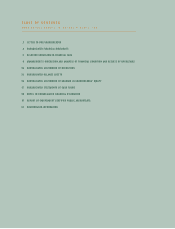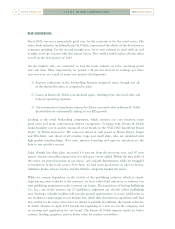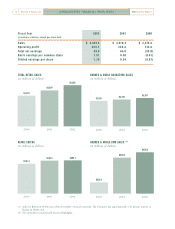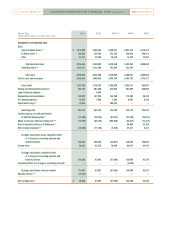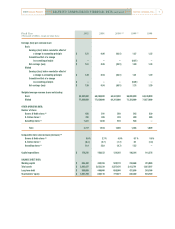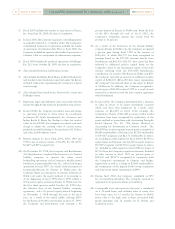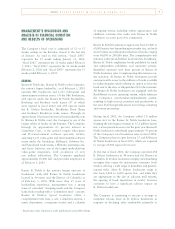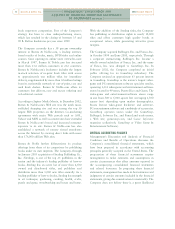Barnes and Noble 2002 Annual Report Download - page 12
Download and view the complete annual report
Please find page 12 of the 2002 Barnes and Noble annual report below. You can navigate through the pages in the report by either clicking on the pages listed below, or by using the keyword search tool below to find specific information within the annual report.
that materially different amounts would be reported
related to the accounting policies described below.
However, application of these accounting policies involves
the exercise of judgment and use of assumptions as to
future uncertainties and, as a result, actual results could
differ from these estimates.
Impairment of Long-Lived Assets and Goodwill
The Company’s long-lived assets include property
and equipment and goodwill. At February 1, 2003,
the Company had $622.3 million of property and
equipment, net of accumulated depreciation, and $438.6
million of goodwill, net of amortization, accounting for
approximately 35.4% of the Company’s total assets.
The Company periodically reviews its property and
equipment under the newly issued accounting
pronouncement Statement of Financial Accounting
Standards (SFAS) No. 144, “Accounting for the
Impairment or Disposal of Long-Lived Assets,”
whenever events or changes in circumstances indicate
that their carrying amounts may not be recoverable or
their depreciation periods should be accelerated.
Factors that the Company considers important which
could trigger a review include the following:
•Significant changes in the manner of use of the assets
•Significant changes in the strategy of the overall
business
•Significant underperformance relative to expected
historical or projected future operating results
Recoverability is assessed based on several factors,
including management’s intentions with respect to its
stores and those stores’ projected undiscounted cash
flows. Assumptions underlying such projected cash flows
include historical experience of stores, competitive
environment, purchasing trends and projected
demographics in the areas.
If it is determined that the carrying value of long-lived
assets may not be recoverable, the Company measures
impairment based on the present values of the projected
cash flows using a discount rate determined by the
Company’s management to be commensurate with the
risk involved.
In fiscal 2002, the Company adopted SFAS No. 142,
“Goodwill and Other Intangible Assets”. SFAS No. 142
requires that purchased goodwill and certain indefinite-
lived intangibles no longer be amortized, but instead
be tested for impairment at least annually. As a result
of adopting SFAS No. 142, the Company ceased
amortization of goodwill beginning February 3, 2002.
Prior to the adoption of SFAS No. 142, the Company
amortized goodwill on a straight-line basis over 30 to
40 years.
SFAS No. 142 prescribes a two-step process for
impairment testing of goodwill. The first step of this
test, used to identify potential impairment, compares
the fair value of a reporting unit with its carrying
amount, including goodwill. The second step (if
necessary) measures the amount of the impairment.
Using the guidance in SFAS No. 142, the Company has
determined that it has two reporting units, bookstores
and video-game and entertainment-software stores. The
Company completed its initial impairment test on the
goodwill in the second quarter of fiscal 2002 and its
annual impairment test in November 2002. Both tests
indicated that the fair value of the reporting units
exceeded that reporting unit’s carrying amount;
accordingly, the second testing phase was not necessary.
The Company has noted no subsequent indicators that
would require testing goodwill for impairment.
Closed Store Expenses
Upon a formal decision to close or relocate a store, the
Company charges unrecoverable costs to expense. Such
costs include the net book value of abandoned fixtures
and leasehold improvements and, when a store is
closed, a provision for future lease obligations, net of
expected sublease recoveries. Costs associated with
store closings of $10.1 million, $9.8 million and $5.0
million during fiscal 2002, fiscal 2001 and fiscal 2000,
respectively, are included in selling and administrative
expenses in the accompanying consolidated statements
of operations.
11
2002 Annual Report Barnes & Noble, Inc.
[MANAGEMENT’S DISCUSSION AND
ANALYSIS OF FINANCIAL CONDITION AND RESULTS
OF OPERATIONS continued ]


